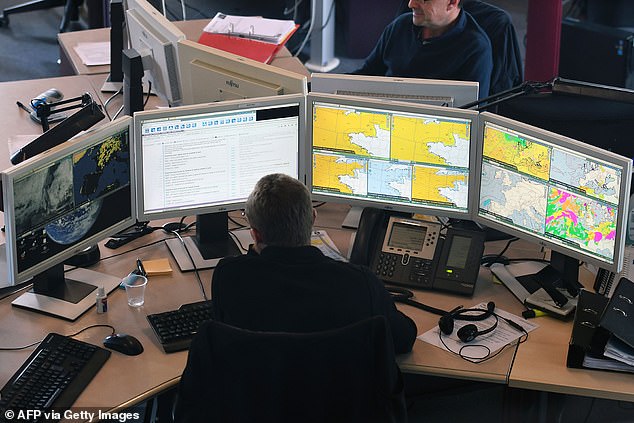The staggering $866 million price tag, Australian taxpayers have scrambled to upgrade the Bureau of Meteorology’s computer systems

The head of the Bureau of Meteorology came under fire during a heated hearing on the estimates on Friday, when a senator unleashed his colleagues’ “anger” on the weather boss.
BoM CEO Dr. Andrew Johnson was recalled to the Senate Environment and Communications Legislation Committee on Friday after failing to answer questions about the agency and its nearly $1 billion IT upgrade earlier this year.
Tasmanian Senator Jonathon Duniam acknowledged that the weather boss had apologized for his ‘lack of willingness to come forward with information’ and then criticized Dr. Johnson for infuriating senators.
“You realize that with your performance, not only according to the latest estimates, but also in previous estimates, you have managed to unite every member of this committee in anger at your unwillingness to answer questions,” he said.
‘It takes a lot for me to lose my patience, and that happened last time too. I don’t want to have to do it again. I don’t think this committee wants to be in the same situation.”
The BoM has been criticized for the costs of its Robust IT project, which was launched after a cyber security breach and major outages in 2015 and 2016.
The project ended in June of this year with a $150 million budget blowout, costing taxpayers $866 million.
That investment, worth approximately $123 million per year, purchased new IT infrastructure, networks and data centers, a new supercomputer for backup and disaster recovery, enhanced security, a new website and a standard operating environment.

The Bureau of Meteorology upgraded its computer systems and weather measurement technology at a cost of almost $1 billion for the Australian taxpayer between 2015 and 2023 (stock image)
The price tag also paid for major upgrades to observation systems, including new and improved radars, automated weather balloon launchers, flood warning equipment and associated communications networks, and improved space weather and flood forecasting technology.
Apart from the huge bill for the technology upgrade, the BOM was also criticized for having a toxic workplace culture and misjudging major weather events.
The Australian Financial Review reported that farmers lost millions selling livestock last summer after the weather bureau forecast a major drought warning that turned into a wet summer.
The agency also said rainfall would ease before a massive downpour flooded parts of north Queensland.

Tasmanian Senator Jonathon Duniam told the head of the Bureau of Meteorology he had angered senators because he was unwilling to answer questions
Dr. Johnson told the committee that the program delivered 90 percent of its size and that the technology deployed was now more secure, stable and resilient as a result of the IT project.
“Robust has also provided a new disaster recovery supercomputer and new and upgraded software applications that support critical services such as floods, thunderstorms and tropical cyclones,” he said.
“It has also delivered a new agency website which is currently being tested by the Australian community.”
Dr. Johnson said the program was around 10 per cent over budget, which was within reasonable tolerances given the unexpected impact of Covid on costs, supply chains and the movement of people.

Director of the Bureau of Meteorology Dr. Andrew Johnson came under fire for the cost of his Robust IT program, which cost taxpayers $866 million
He added that the funding allocated in the 2021 budget would cover any transition work to maintain the benefits of the program.
“No new funding will be requested for this transition work during its lifetime. Robust was subject to a comprehensive assurance and assessment program during the most recent gateway review conducted in September 2024,” he said.
“The panel concluded that Robust has been successful, its governance has been highly effective, and its performance has been significantly better than other comparable programs within government. Robust is ‘a good news story.’
Dr. Johnson said that as a result of the project, the agency’s system has become more secure and less vulnerable to attack by entities whose interests are not aligned with the nation.
“Unfortunately, we are constantly being attacked by these entities,” he said.
He told the committee there would be fewer network outages and they would be able to respond more quickly to outages with less impact on the community.
“Whether it’s forecast warnings, space weather imagery or any radars, whatever it may be, we have the ability to come back quickly,” he said.
“The second disaster recovery supercomputer is a massive intervention to reduce risk, but also a national asset that we are working more broadly with the Australian scientific community to make available for other uses.
‘A whole lot of new equipment has come on board, new radars, new flood meters, balloon launches that bring profiles through the atmosphere,
“We have better and more reliable data and better forecasts and warnings that we can provide to the community.
“We’ve also upgraded a lot of our software and other applications, so our new tropical cyclone warning service, new flood capabilities, flood warning capabilities and tsunami warning capabilities.”




